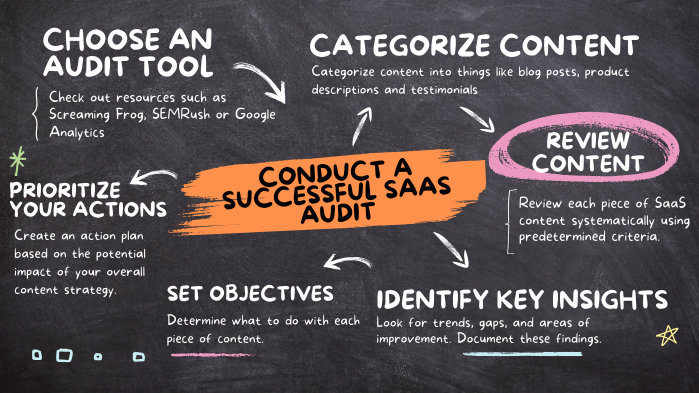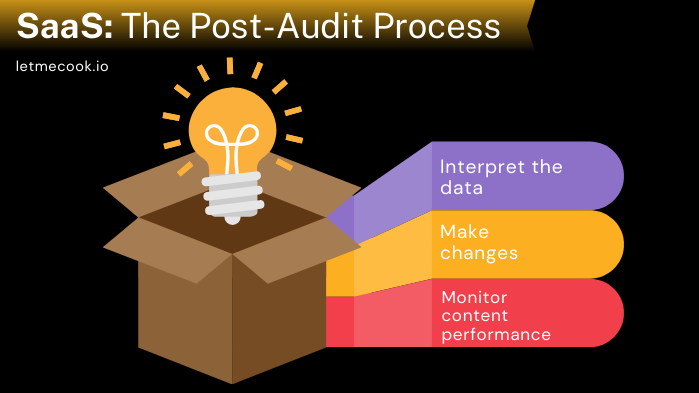This article contains affiliate links – but that doesn’t mean this piece is an ad.
All content is our honest take on the service/product and incorporates our
real thoughts and experience using it.
If you don’t market your business, no one is going to know it exists. It doesn’t matter how much work you put in. How many hours you spent grinding in a coffee chop cracked out on espresso doesn’t matter. Or how many times you cried yourself to sleep on your friend’s couch when you had nowhere else to go.
Get your company out there. It’s time to show the world what you can do. You made the content for it. Now make sure it’s firing on all cylinders Why? Because marketing matters more than most people think. LinkedIn found that around 45% of marketers in the B2B sphere expect to increase their content marketing budget in 2024.
It’s time – for an audit! This process is about examining your existing content. You need to understand its impact and plan for future content strategies.
But what exactly is a SaaS content audit, and why is it so crucial for your business? More importantly, how can one go about conducting it? Let’s dig into these questions and help you lay a solid foundation for your success.
Table of Contents
What Is a Content Audit for SaaS?
First…you didn’t do anything wrong. So don’t freak out.
Orrrr….maybe you did.
You won’t know until you complete this process.
A content audit is a strategic analysis of all the content on a website. This includes everything from B2B SaaS marketing blog posts to product pages.
Its purpose is to determine what content is performing well, what is not, and how to improve it. It’s an excellent opportunity to ensure all content aligns with the website’s purpose, target audience, and messaging.
SaaS content optimization helps to identify gaps in what you’re doing – which can help get your website in front of my eyeballs. More eyeballs turn into more sales (If your product is solid…that we can’t help you with. But there are agencies that can by providing valuable insights and suggestions).
This process is crucial for website owners and marketers who want to ensure their website delivers the right message.
To the right people.
At the right time.
A thorough content audit for SaaS companies leads to better engagement, increased traffic, and more conversions.
SaaS Content Optimization – Why You Need It

As a SaaS company, you understand the importance of constantly adapting and improving your product. You need to meet the ever-changing needs of your customers. The same principle applies to your website’s content.
A regular audit can help you stay on top of trends and ensure that your Saas content writing is always relevant and resonating with your audience. It can help you identify outdated or inaccurate information that may harm your brand’s credibility.
It also provides an opportunity to uncover new keywords and topics that can boost your SEO efforts. The TLDR? – A content audit is one of the best practices for SaaS websites that can lead to a more efficient and effective digital marketing strategy, resulting in higher customer acquisition and retention rates.
When Is the Best Time to Conduct an Audit?
We’ll tell ya…It’s right now. Today. ASAP.
As with any marketing strategy, the earlier you start, the better. However, it’s never too late to start if your website has been live for some time and you haven’t yet conducted a content audit.
Many companies do it when revamping their website or launching a new product. This allows them to ensure that all content is in line with their new messaging and branding.
Conducting a content audit for SaaS businesses at least once a year is beneficial to stay on top of any changes in your industry or target audience.
Let’s Get Technical: 8 Steps to Conduct a SaaS Content Audit

Now that we have established what a SaaS content audit is and why it’s essential, let’s dive into how you make it all happen. With proper planning and execution, it can be a smooth and efficient experience. Here are 8 key steps to follow when conducting your audit:
- Choose a Content Audit Tool: Several online tools can help streamline your content audit. Resources such as Screaming Frog, LowFruits, or Google Analytics are great choices. These tools can crawl your website and generate a comprehensive list of all pages. They also provide metrics like page views, bounce rates, and more. Essentially, they help to define your goals.
- Categorize Your Content: As you gather data, begin to categorize your content into different types. This will include blog posts, product descriptions, and testimonials. You can also include themes like customer support product updates. These are just a few ideas, you can break them up as you see fit.
- Review Each Piece of Content: Systematically review each piece of SaaS content writing using predetermined criteria. This could include relevance, accuracy, completeness, readability, and SEO value.
- Identify and Document Key Insights: Look for trends, gaps, and areas of improvement. Ensure to document these findings for later review and action.
- Set Objectives for Each Piece of Content: Determine what to do with each piece. You can keep it as is, update it, merge it with other content, or remove it entirely. If you’ve chosen the right tools for the job, they should be able to help with this step.
- Prioritize Your Actions: Based on your objectives, create an action plan. Prioritize actions based on their potential impact on your overall content strategy.
- Apply Changes: Carry out the actions determined by your audit. This could involve revising content, removing outdated pages, or creating new content to address identified gaps.
- Track and Measure Impact: Keep an eye on key metrics to assess the impact of your changes. Continuous monitoring will also help you identify new opportunities or issues as they arise.
Evaluating Your Content: The Key Metrics
As the saying goes, “What gets measured, gets managed.”
When it comes to evaluating the performance of your website’s content, content audits are a critical piece of the puzzle. But what metrics should you be paying attention and why do they matter?
First, look at engagement metrics, such as bounce rate and time on page. These metrics can give you a sense of how well your content is resonating with your audience.
Next, consider conversion metrics, such as click-through rate and conversion rate. Are your readers taking action as a result of your content? If they aren’t, the next step is to find out why. Where are you losing them?
Finally, don’t forget to track your social sharing metrics. They give you insight into how shareable and valuable your content is to your audience.
Tracking these key metrics consistently allows you to make data-driven decisions about improving your content strategy.
Implementing Changes: The Post-Audit Process

A content audit is not a one-time event but rather an ongoing process. As your SaaS product evolves, so should your content strategy.
- Step 1 – Interpret the Data: What are you seeing? Where is traffic going? How are they getting there? How are your conversion rates on high and low-traffic content? Are there any patterns?
- Step 2 – Make Changes: Once you’ve completed your data analysis, it’s time to make some changes. Fix your content and website. Maybe it’s slow. Maybe you need CTAs in blog posts. Maybe you need more top-of-the-funnel content. Maybe you need more bottom-of-the-funnel content. Maybe your content isn’t utilizing keywords properly.
- Step 3 – Monitor: We all struggle with this facet. It’s like going to the gym. You want to lose 20 lbs. Then you do and slide right back into bad eating habits, quit going to the gym, and the weight comes right back on. An audit can get you on the right track, but you need to monitor your content’s performance to make sure it stays that way.
Continually auditing and optimizing your content keeps you ahead of the competition by providing valuable information to your audience. This is why a SaaS content audit is essential for any successful digital marketing strategy.
Leveraging a SaaS Content Audit for Future Success
As you might have figured out, the SaaS content audit is not just a one-and-done process. It’s an ongoing tool that can help guide your future content strategy.
By regularly conducting audits and identifying gaps in your content, you can plan and create new content that addresses the needs and interests of your target audience. However, there’s a fine line between doing what’s needed and overkill. It’s up to you to figure out where that line is for your company.
Tracking key metrics and implementing changes based on data-driven insights can help you continuously improve the effectiveness of your content. So, don’t underestimate the power of this process in driving future success for your product or company.
With its help, you can achieve SaaS digital marketing excellence and stand out in a crowded market.
It’s a resource-heavy investment. And investing time and effort into regularly conducting SaaS content audits will set you up for success in what can be a relentless and ruthless industry.
Do yourself a favor. Don’t wait any longer.
Remember, it’s not about having a lot of content. It’s about having relevant, high-quality content that speaks to your audience and drives results.
Embracing the SaaS Audit Process
Conducting regular content audits is a non-negotiable strategy for long-term success. It’s about curating high-quality, relevant material that resonates with your target audience.
By systematically evaluating your content, tracking key metrics, and making data-driven updates and enhancements, you can continually refine your content strategy.
Make the most of the insight gained from content audits. Use it to guide your future content creation efforts and to adjust your overall strategy. The investment in time and effort will pay off in the long run, propelling your SaaS company toward excellence.





Thanks for sharing. I read many of your blog posts, cool, your blog is very good.
It’s our pleasure, glad you are enjoying them!
Your article helped me a lot, is there any more related content? Thanks!
We are happy to hear that! You should check out our B2B SaaS marketing blog post and the content writing for SaaS article.